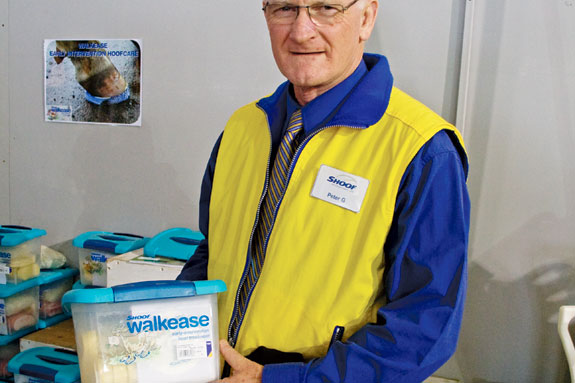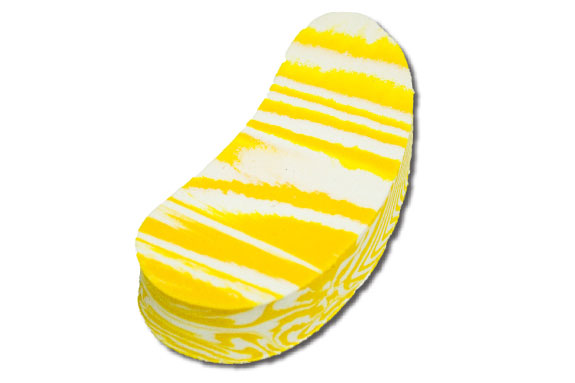This article was #2 in PDmag's Top 5 most-well read New Technology articles in 2010. Summary: The Walkease hoof block, created by Shoof International, is made from ethylene vinyl acetate, or EVA foam. The new foam hoof block sticks to a hoof with a one-step “super glue” for anywhere from one week to 14 days. It was designed to give producers and veterinarians an option for an early intervention hoof care treatment. Because this article was so popular, we asked Katie Klessig of ANIMART Inc. some follow-up questions:
Q: What type of interest have you received? Can you quantify it in anyway?
KLESSIG : The article in Progressive Dairyman was very helpful in building interest. Walkease has received a lot of interest from hoof trimmers, veterinarians and dairy producers. We are just starting with a marketing campaign and building awareness.
Q: Have you made any modifications to the original product?
KLESSIG : No, it is the same product. It was researched very well and it hasn’t had to go through much modification after it was launched.
Q: Are you working on any additional features, enhancements or new options?
KLESSIG : At this point we encourage customers and others to visit us online at our newly launched website, www.WalkeaseUSA.com and let us know their comments about the product.
Q: Have any of your customers found a use or benefit you hadn’t thought of?
KLESSIG : Vets have found that instead of using a standard blocking system, they can use the Walkease and follow-up on the cow the next day.
Q: Were there any hurdles that needed to be overcome?
KLESSIG : Creating awareness and educating the dairyman and his hoof trimming team as well as communicating with the professional hoof trimmer so they are aware of the Walkease product, and helping them understand the early use of Walkease versus the traditional therapeutic blocking system.
Q: What is the No. 1 reason customers cite for buying this product?
KLESSIG : This simple, do it yourself system allows the most novice farm hand to be proactive in early detection and treatment of sore and lame cows. Our first U.S. showing of the product was at the World Dairy Expo in Madison, Wisconsin. Given the type of enthusiastic feedback we received from booth visitors we have decided to have a booth in the new products tent in Tulare,CA at the World Ag Expo. We hope everyone stops by to see first hand to see how Walkease is a new staple for every trimmer, vet and dairymen to keep close at hand. PD
PLUS, check out Progressive Dairyman 's Top 25 most well-read articles .
ARTICLE
What do you get when you cross a hoof with superglue and a neon-colored hoof block? A new, short-term fix for treating mild hoof sores, say hoof trimmers who have used Shoof International’s Walkease hoof block.
“It’s a great, temporary fix for when you want to get her off her claw for a short period of time to let it heal,” says Brandon Beavers, owner of Beavers Hoof Care Service in Lebanon, Kentucky. “I use them anywhere from five to 10 times a week.”
( Be sure to view the below of the application of the Walkease hoof block. )
These new hoof blocks are made from ethylene vinyl acetate, otherwise known as EVA foam. The material has been used for years to make everyday objects such as yoga mats, sports equipment padding and sandals.
Because the foam blocks are made from a shock-absorbent material, Beavers says that it takes some strain away from a cow’s leg joints and muscles. “It isn’t as hard or abrasive as wooden blocks.”
The new foam hoof blocks stick for anywhere from one week to 14 days, but they aren’t meant to compete against wooden and hard rubber blocks. “The alternatives (wood blocks) still have a very significant place for serious lameness,” says Peter Griffiths, inventor of the new product. “The Walkease hoof blocks just give an option for an early intervention of treating the hoof.”
With warts and ulcers being the most prominent cases of lameness that Beavers sees, blocks are usually the product of choice for the healing process. But some ulcers are not serious enough to need extended healing time with a wooden block. Plus, a wooden or plastic block can be a relatively expensive treatment given low milk prices, costing on average $20 per cow for a trimmer to apply the block, while the foam block can be applied by anyone for around $5. And with circumstances like that, Beavers says the foam block is perfect for the job.
“You don’t have to worry about it,” says Beavers. “In the week to two-week range, you know the block is going to come off and the animal is going to be fine.”

A hoof trimmer or an on-farm herdsman applies the foam hoof block much like he would a wooden one. He starts by cleaning and leveling the healthy claw of the hoof with a giant nail file, called a surform rasp. Then, he applies the one-step “superglue” to the block, presses the block onto the clean claw and holds it for about 10 seconds. He releases the leg, letting the cow put pressure on the block to complete the application process.
The foam blocks come in three different colors: red, yellow and blue. Each color corresponds with a small, medium or large hoof size. They can be bought in groups of 10 or as a starter kit comprised of 10 foam hoof blocks, the unique superglue, a surform rasp and rubber gloves.
The one-step glue is also a new product because it is simple to use and fast-drying, taking seconds to set, unlike other hoof glues that require a two-step adhesive process. It is called “superglue” because it works like regular superglue that is commonly used today.
“We wanted to find a glue that would dry very quickly, but still give us normal strength,” Griffiths says.
Three years ago, Griffiths decided that there was no alternative for wooden blocks and temporary hoof care. So, after coming up with the idea for the foam block, it took two years of conducting many tests with different materials and glues for the Walkease to be at the point of exceeding the company’s expectations. As for the name?
“We had a bit of a competition in the company amongst the staff, and then the managing director’s wife came up with the ‘Walkease’ idea because it quite well describes how it makes the animal walk – easily,” Griffiths says.
Griffiths also says that the blocks are durable in any type of climate. The blocks have been tested to last the average week time period on all surfaces from grass to concrete. The block absorbs little moisture and has no known negative effects on the environment or handlers. After falling off, they can be thrown out with the trash.
“Because it is economical and easy to fit, they can treat the animal early, rather than leaving it until it’s a more serious situation,” Griffiths says. “So the animal that has been treated early can carry on, producing effectively in the herd.” PD
The following checklist can be used to determine if this new technology might be a fit for your operation.
1. Do you account for proper hoof care and treatment in milk production?
2. Do you have your cows’ hooves trimmed regularly by a trimmer?
3. Do you currently pay for wooden or plastic blocks for your cows?
4. Do you have more than a four-week wait period in between trimmer visits?
5. Do you have a basic knowledge of hoof care?
If you answered yes to three or more of these questions, this new technology may be one for you to consider.
VIDEO



